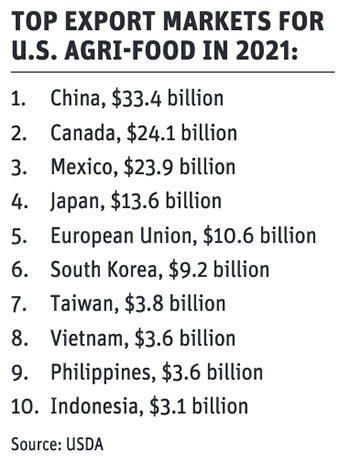Firms exported $3.6 billion of ag products to Vietnam, $3.6 billion to the Philippines and $3.1 billion to Indonesia last year
If the American relationship with China gets “frosty,” the United States needs alternative markets for soybeans, corn, pork and other agricultural commodities, says the U.S. Department of Agriculture’s leader of international market development.
Daniel Whitley, administrator of the Foreign Agriculture Service, said his staff are looking to expand agri-food trade and one region is the most promising.
“Number one, in my mind, is Southeast Asia,” said Whitley, who spoke at the USDA’s Agriculture Outlook Forum, a virtual event held in February.
“Vietnam, Thailand, Malaysia, Indonesia and the Philippines… if you look at the macro-economic profile of that region of the world, we’re talking about the fastest growth of consumers from low income to middle class.”
The population of those five countries does not match the 1.4 billion people in China, but collectively the total is more than 600 million, which is larger than Europe:
- Indonesia: 273 million
- Philippines: 109 million
- Vietnam: 97 million
- Thailand: 70
- Malaysia: 33 million
The FAS, which has 100 offices around the globe and a mandate to expand export opportunities, has already found success in parts of Southeast Asia.
In 2021, American firms exported US$3.6 billion worth of ag products to Vietnam, $3.6 billion to the Philippines and $3.1 billion to Indonesia.
That’s much less than the $33.4 billion it sold to China last year, but there’s an opportunity to boost those figures, Whitley said. Diets in Southeast Asia are evolving because people are getting richer. Millions can now afford to dine at restaurants and eat meat several times per week.
“We’re talking about… tastes and consumption patterns that are being more westernized, each and every single day.”
Some sectors in Canada’s agri-food industry are also building sales to Southeast Asia. Last year, pork exports to the Philippines were more than $300 million, making it the fifth largest market for Canadian pork.
Canadian beef is gaining traction in Vietnam. For the first 11 months of 2021, beef exports to Vietnam were $85 million, up from $40 million during the same period in 2020.
For the sake of comparison, Vietnam is now a more important market for Canadian beef than Europe. Last year, from January to November, Canada sold only $17 million worth of beef to the EU, even though Canada has a trade deal with Europe.
Like the U.S., Canada is targeting Southeast Asia for more trade in all goods and services.
In November, Canada and the Association of SouthEast Asian Nations, which represents 10 countries, agreed to begin negotiations for a free trade agreement.

During the question-and-answer part of his presentation, Whitley pointed to the Middle East as another region with trade potential.
“That’s quickly becoming a fast number two (behind Southeast Asia),” he said.
“There is (already) a presence in the region of so many of our companies and so many of our businesses.”
In another session at the USDA Ag Outlook Forum, the U.S. Trade Representative said agricultural trade between America and China is becoming more hostile.
“(It is) extremely difficult and getting more difficult,” said Katherine Tai.
Whitley and other FAS experts could be spending more time in Manila, Jakarta and Bangkok, if America’s relationship with China gets nasty.
“We need to identify and build out some of these new markets… so we can be better prepared,” he said. “$35 billion to one market (China) is nothing to sneeze at. And it is not easily replaced.”
















